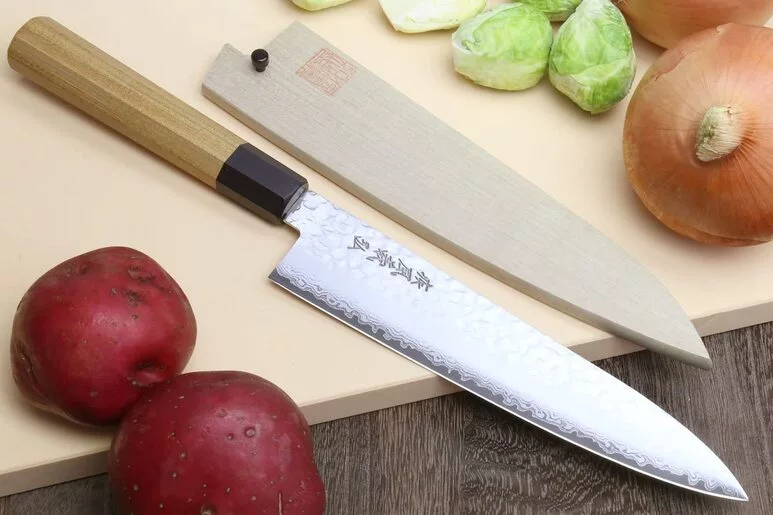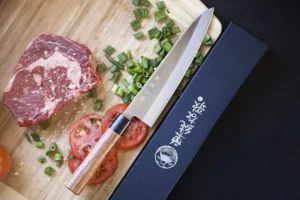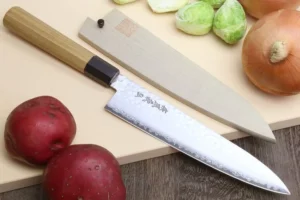Table of Contents
Before using a knife, the first thing you look at is how sharp the edges are. The sharper the blade, the easier your work, and that’s why your knife’s bevel is crucial.
The slant or angle that slopes your knife’s edge determines how sharp it will be. Different types of knives have various sharpness angles depending on their intended purpose.
In this article, we will limit ourselves to discussing the two major categories of bevels which are Single bevels and double bevels knives. Which knife should you go for and why? Let’s get straight into the discussion.
Single bevel vs Double bevel knives.
The main difference between a Single bevel knife and a Double bevel knife is that a single bevel knife’s edge angle is formed on one side while A double bevel knife’s edge angle is formed on both sides and is more common due to its versatility.
Single bevel knives
A single bevel knife, also known as a chisel edge, features only one sharp angle on its edge. Thus, the single bevel knives are only sharpened on one edge, creating small angles. The single beveled blades are the epitome of sharpness and precision.
The knife is a one-hand use blade. Most single beveled knives available in the market are designed for right-handed users. If your left hand is more prevalent, ensure that you get a suitable blade for you.
Single bevel knives are task-specific. The Yanagiba knife, for example, is used in the preparation of sashimi. The blades also need advanced handling skills. Thus, single beveled knives are more popular among professional chefs.
Pros and cons of single bevel
Pros
- The blade of a single bevel knife is sharp.
- It is easy to sharpen the knife.
- The knife offers good precision cuts.
Cons
- Single bevel knives are less versatile.
- The blades are less durable.
What angle do you sharpen a single bevel knife?
You can sharpen the single bevel angle knife at an angle of between 15 to 17 degrees. A whetstone is more preferable while sharpening the knife, but you can also use a normal-sided sharpener.
If you are using a whetstone, ensure that the stone is flat before you start. The most important thing to note is that you only need to sharpen only the bevel side of the blade.
Why are Japanese knives single bevel?
The single bevel knife is the Japanese cultural knife. In Japan, the preference for single bevel knives stems from centuries of tradition. Single bevel knives are popular with Japanese chefs because of their extreme sharpness. The blade allows long and precise cuts for the vegetables and the delicate meats. Some of the most popular tasks of the single bevel knife are slicing, chopping, and dicing.
The conventional Japanese single bevel knife features three parts. The shinogi is the flat part of the blade. The urasuki is the concave part of the knife, while the uraoshi is the super sharp edge.
Some popular traditional Japanese single bevel knives are the USuba, the Deba, and the Yanagiba. The Deba tops the ranks as the best single bevel knife in the market due to its versatility in use.
View this Traditional Single Bevel Knife
Double Bevel knives
The double bevel knife slopes at both sides of the blade from the spine, forming two sharp edges. Thus, a double bevel knife is sharpened from both sides. The double bevel knife is the most common blade, especially in the Western kitchen.
When cutting food with a double bevel knife, the knife pushes the food slices away on both sides. Thus, the cut part falls away from the knife blade.
Cuttings may stick on the edge when chopping stick food such as fish or cheese. The stuck food hinders the passage of the knife. The double bevel knife may not give you the clean cuts you get from the single bevel knife.
Double bevel knives are more ambidextrous in use. Both right-handed and left-handed people can use the same knife with ease. Also, the knives are easier to handle and more friendly to less professional users.
The double bevel knife has more steel behind the cutting edge. The blade is more robust as it rocks on the surface of the chopping board and is unlikely to roll over.
The disadvantage of this feature is that the angle needs to be bigger than single beveled knives. Large angles cannot be as detailed and are therefore less sharp.
The double bevel knife is a multiple-purpose blade. The robustness of the blade makes it ideal for handling challenging tasks. You can use the knife to chop the tough meat and peel wild fruits.
The Japanese started creating double bevel knives due to the Western market demand. Some of the famous Japanese double-beveled knives are the Nakiri and the Santoku.
Pros and cons of double Bevel
Pros
- The double bevel knife is multi-purpose.
- It is more robust and more durable.
- It is ambidextrous
- It is more versatile.
Cons
- Not suitable for precision cuts
- It is more difficult to sharpen.
What angle do you sharpen a double bevel knife?
You can sharpen the double bevel knife at an angle between 20 to 30 degrees on each side. Sharpening at a higher 30 degrees angle is more suitable if you want to use the knife for demanding tasks.
You can use a sharpener or whetstone to sharpen the blade. The whetstone is more recommendable as it creates the same angle on both sides.
View this Yoshihiro Double Bevel Gyuto Knife
Is a single bevel better than a double bevel knife?
The single bevel knife has the upper hand over a double bevel knife if you are looking for precision and sharpness. The blade is super thin and sharp and provides neat results in precision cuts.
But, as we have seen, single beveled knives are one-hand use. The knives also need good handling skills and may not be ideal for less professional users.
Single bevel knives are also task-specific. You may need to refrain from using the knife to handle complex tasks. Tasks such as cutting through bones may cause the thin sharp edges to chip.
The double bevel knife is your day-to-day regular kitchen knife. The knife does not need professional handling skills. The blade is also more robust and can handle a variety of tasks.
Conclusion
When comparing a single bevel vs. a double bevel knife, the best choice depends on the task at hand and your experience with knife handling.
The single bevel knife is the preferred professional precision knife while the double bevel knife is a perfect choice if you want a more versatile kitchen knife.






